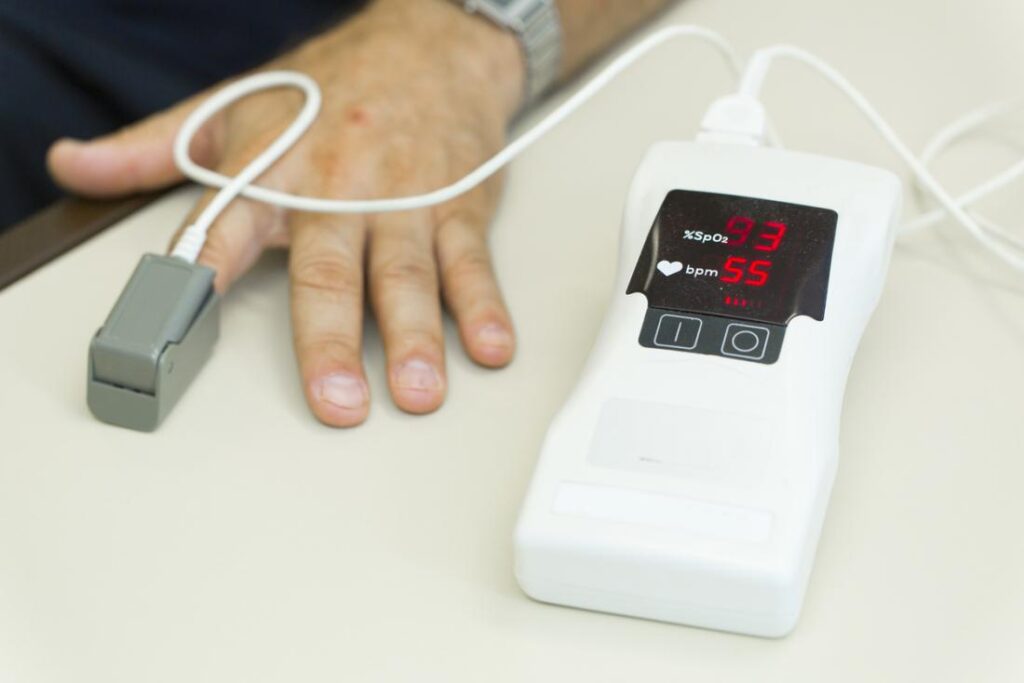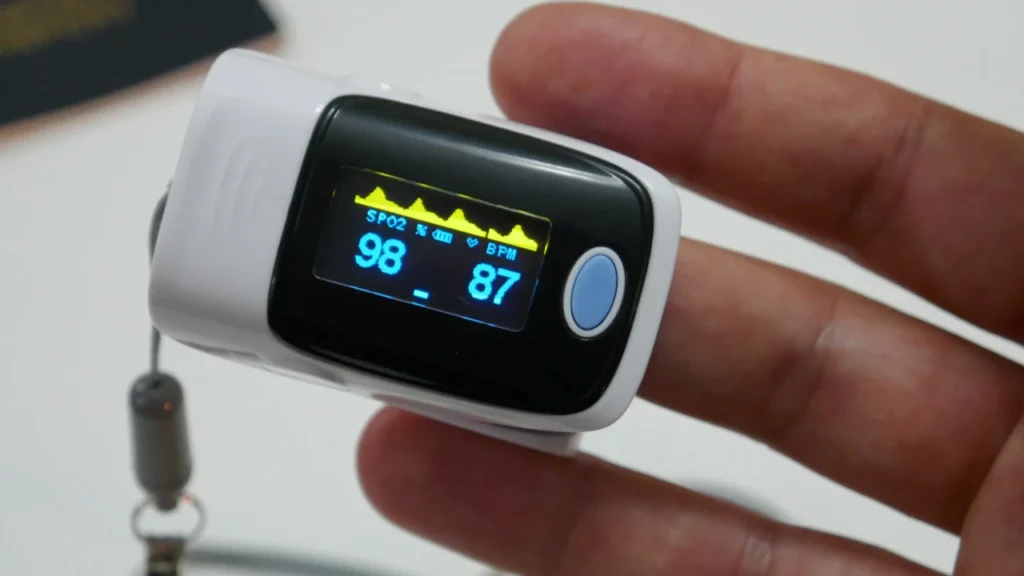Blog
How to Use Pulse Oximeters to Monitor Your Oxygen Levels
Pulse oximeters have become essential tools for monitoring oxygen saturation levels (SpO2) and pulse rate, providing valuable insights into respiratory and cardiovascular health. Whether you’re managing a chronic condition, recovering from an illness, or simply keeping tabs on your health, pulse oximeters offer a non-invasive and convenient way to measure vital signs.
In this comprehensive guide, we’ll explore how to use pulse oximeters to monitor your oxygen levels, the benefits they provide, and tips for ensuring accurate readings.
1. What Is a Pulse Oximeter?
A pulse oximeter is a small, portable device that measures oxygen saturation in your blood and your heart rate. It works by shining light through your fingertip (or another translucent area of the body) and analyzing how much oxygen your red blood cells are carrying.

Key Components of a Pulse Oximeter:
- Display Screen: Shows SpO2 levels, pulse rate, and sometimes a plethysmograph (a graph of blood flow).
- Sensor: Detects oxygen levels and pulse using infrared light.
- Clip Design: Fits snugly on a fingertip, earlobe, or toe.
2. Why Monitor Oxygen Levels?
Monitoring oxygen levels can provide critical insights into your overall health. It’s especially important for individuals with respiratory or cardiovascular conditions.
Common Reasons to Use a Pulse Oximeter:
- Chronic Conditions: Monitor oxygen levels for conditions like COPD, asthma, or heart disease.
- COVID-19 Recovery: Detect signs of hypoxia (low oxygen levels) early.
- Fitness Tracking: Assess oxygen delivery during exercise or high-altitude activities.
- Sleep Monitoring: Identify potential issues like sleep apnea.
By regularly measuring SpO2 levels, you can catch potential problems early and take preventive action.
3. How to Use a Pulse Oximeter
Using a pulse oximeter is straightforward, but following the correct steps ensures accurate readings.
Step-by-Step Guide:
Step 1: Prepare the Device
- Ensure the pulse oximeter is fully charged or has fresh batteries.
- Clean the sensor with a soft cloth or alcohol wipe.
Step 2: Choose a Suitable Finger
- Select a fingertip with good blood flow, typically the middle or index finger.
- Remove nail polish or artificial nails, as they can interfere with accuracy.
Step 3: Position the Oximeter
- Place the clip on your fingertip, ensuring the sensor covers the pad of your finger.
- Keep your hand still and relaxed.
Step 4: Wait for the Reading
- Hold your hand steady for 10–20 seconds.
- Read the SpO2 percentage (oxygen saturation) and pulse rate on the display.
Step 5: Record Your Results
- Note the readings or sync them with an app if your device supports Bluetooth.
4. Understanding Pulse Oximeter Readings
Oxygen Saturation (SpO2):
- Normal Range: 95%–100%.
- Mild Hypoxia: 90%–94%.
- Severe Hypoxia: Below 90%.
Pulse Rate:
- Normal Resting Pulse Rate: 60–100 beats per minute (bpm).
If your readings fall outside the normal range consistently, consult a healthcare provider.
5. Tips for Accurate Readings
To ensure reliable results, follow these best practices:
- Avoid Movement: Minimize hand or body movement during the reading.
- Warm Your Hands: Cold fingers can reduce blood flow and affect accuracy.
- Stay Calm: Stress or rapid breathing can skew results.
- Use Proper Positioning: Sit or lie down comfortably with your hand resting at heart level.
- Check Battery Levels: A low battery can cause unreliable readings.
- Repeat Readings: If a reading seems off, wait a minute and try again.
6. When to Use a Pulse Oximeter
Daily Monitoring:
- Chronic conditions like COPD or heart disease may require regular checks.
During Exercise:
- Athletes and fitness enthusiasts can monitor oxygen delivery and recovery.
At High Altitudes:
- Use during mountain climbing or traveling to areas with lower oxygen levels.
During Illness or Recovery:
- Monitor oxygen levels if you’re experiencing symptoms of COVID-19, flu, or pneumonia.
7. Benefits of Using a Pulse Oximeter
1. Early Detection of Health Issues:
- Identifies low oxygen levels before symptoms worsen, enabling timely medical intervention.
2. Non-Invasive Monitoring:
- Measures oxygen levels without needles or invasive procedures.
3. Enhanced Fitness Tracking:
- Helps athletes optimize workouts by monitoring oxygen levels during physical activity.
4. Support for Chronic Conditions:
- Provides consistent data for managing diseases like COPD or asthma.
5. Peace of Mind:
- Regular monitoring can alleviate anxiety by confirming healthy oxygen levels.
8. Choosing the Right Pulse Oximeter
When selecting a pulse oximeter, consider the following factors:
- Accuracy: Look for FDA-approved models or those meeting ISO standards.
- Ease of Use: Choose a device with a clear display and simple instructions.
- Portability: Compact designs are ideal for on-the-go use.
- Battery Life: Opt for devices with long-lasting batteries.
- Advanced Features: Some models offer Bluetooth connectivity, app integration, or plethysmograph graphs.
9. Top Pulse Oximeters to Consider
1. Masimo MightySat
- Features: Advanced metrics, Bluetooth connectivity, and respiratory rate tracking.
- Best For: Athletes and individuals needing detailed analysis.
2. Wellue O2Ring
- Features: Continuous monitoring, comfortable design, and smartphone integration.
- Best For: Sleep apnea monitoring and chronic condition management.
3. Zacurate Pro Series 500DL
- Features: Affordable, easy-to-use, and suitable for general use.
- Best For: Families and everyday monitoring.
4. Innovo Deluxe iP900AP
- Features: Plethysmograph display and precise measurements.
- Best For: Individuals seeking high accuracy.
10. Common Misconceptions About Pulse Oximeters

1. They Replace Professional Care:
Pulse oximeters are helpful tools but not substitutes for professional medical evaluation.
2. Readings Are Always Accurate:
External factors like cold hands or poor device placement can affect accuracy.
3. They Diagnose Illness:
Pulse oximeters monitor oxygen levels but cannot diagnose underlying conditions.
11. When to Seek Medical Attention
If your pulse oximeter consistently shows SpO2 levels below 90% or you experience symptoms like difficulty breathing, confusion, or chest pain, seek immediate medical care.
12. Future of Pulse Oximeters
The future of pulse oximetry includes advanced features like:
- Wearable Designs: Continuous monitoring via smartwatches or rings.
- AI Integration: Enhanced data analysis for predictive insights.
- Expanded Metrics: Tracking additional health indicators like hydration or stress levels.
These innovations will make pulse oximeters even more valuable for personal health management.
Conclusion
Pulse oximeters are powerful tools for monitoring oxygen levels and pulse rates, helping individuals stay proactive about their health. Whether you’re managing a chronic condition, recovering from illness, or tracking fitness, these devices provide valuable insights into your well-being.
By understanding how to use a pulse oximeter correctly and interpreting its readings, you can make informed decisions about your health and seek timely care when needed. Invest in a reliable pulse oximeter today and take control of your health with confidence.

